|
|
Hamburg

|
|
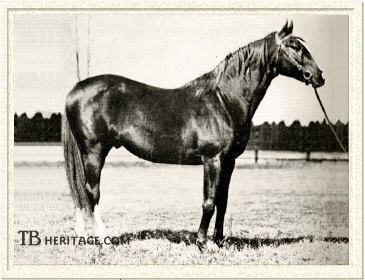 |
|
|
Hamburg was one of the most royally bred colts of his generation. His sire was the mighty Hanover, winner of the Belmont Stakes and thirty-one other races. Paternal grandsire of Hamburg was Hindoo, a winner of the Kentucky Derby, the Travers Stakes, and thirty of his thirty-five starts in all, including eighteen races in succession.
Hamburg's dam was Lady Reel, a half-sister to the brilliant Domino, and bred by by the same man, Major Barak Thomas. She was by the fine racehorse and sire Fellowcraft, a full brother to Spendthrift. She was one of six stakes winners from her dam, Mannie Gray. She won the Beacon Stakes and five other races during her two years on the turf, all but one of them under a mile. Lady Reel passed through several hands during her lifetime, and of her produce only Hamburg proved distinctive; the rest ran and won mostly at selling plate level, and seldom ran over a mile, although Amanda V., by Strathmore, did win the Debutante Stakes and La Belle Stud Stakes.
In 1894, Lady Reel was a young mare in the broodmare band at the McGrathiana Stud of Col. Milton Young. That year, along with thirteen other mares, she was purchased by J.E. Kittson. Her foal by Young's stallion, Strathmore, had died, and, as part of the sale agreement, Young allowed her new owner to breed her back to Hanover. After being confirmed in foal, Kittson then sold Lady Reel to Col. J. Enright, and she joined the broodmare ranks at lush Elmendorf Farm outside Lexington, Kentucky, which Enright had recently purchased from Daniel Swigert. Later in life, Lady Reel passed into the hands of Marcus Daly, who would campaign Hamburg during his sophomore season. Following his death, she wound up in Great Britain, where she produced two known foals by St. Simon, but they were of little account.
The result of the 1894 breeding to Hanover was Hamburg, a robust bay colt with a broad blaze and two white hind stockings. He was fiery in temperament and gave every indication that he was a young horse of exceptional merit. He was sold as a yearling to John E. Madden, who had made his reputation as a breeder and trainer of trotting horses. When he later established Hamburg Place on the Winchester Pike outside Lexington, he owned and managed both standardbred and thoroughbred mares; trotting immortals such as Nancy Hanks grazed the same pastures as the likes of the thoroughbred matrons Imp, Lady Sterling, Miss Kearney, and Ida Pickwick.
Hamburg proved one of the most difficult horses Madden ever broke. The colt was strong and high-spirited, and bucked exercise boys off his back at every opportunity.
Eventually, he found a boy who was able to stay on Hamburg, and the colt's training proceeded to Madden's satisfaction. The youngster had speed and talent, and, in addition, a monstrous appetite, and Madden had to work the colt extra hard to keep him from getting fat.
Hamburg raced sixteen times as a two-year-old, and won twelve of those starts. He was fast, and he was able to break with great speed, in part attributable to the power generated from his enormous quarters and gaskins. The colt's usual method was to break on top and never look back. Hamburg won two of his first three starts before he cracked stakes company in the Great Trial Stakes at Sheepshead Bay, which he won by four lengths in a common canter. This easy victory meant weight would be packed on, and in his next start, the second half of the Double Event at Sheepshead Bay, he carried 129 pounds, and led, gate to wire, to win by two lengths. Hamburg also carried 129 pounds to an easy victory in the Flash Stakes at Saratoga, and then in his next appearance, successfully won the Congress Hall Stakes with 134 pounds, something no other two-year-old had done before. He was beaten by a head by Archduke, to whom he gave twelve pounds, in his next race, the Grand Union Hotel Stakes. He went on to Brighton Beach to win the Generation Stakes under 127 pounds, and the Electric Stakes under 132 pounds.
September, 1897 was grueling for the colt, for he started six times and emerged victorious on four of those occasions. Madden sent him out in the Flight Stakes against older horses. Hamburg led until the stretch turn and then gave way to Requital, a four-year-old who was also receiving five pounds from the younger horse. A five-year-old, Flying Dutchman, finished ten lengths behind Hamburg in third place. He also lost his next race, the Flatbush Stakes, by a head to Phil Dwyer's Previous. He then won his next four races: the Autumn Stakes under 129 pounds, the Great Eastern Handicap under a crushing 135 pounds, the Prospect Stakes under 127 pounds, and the Excelsior Stakes. In these final four victories, Hamburg was partnered by jockey Fred Taral, who had been Domino's regular rider.
Hamburg's juvenile season had been brilliant, and although he was not the top money-earning juvenile in his year -- Futurity winner L'Alouette was -- the consensus of the turf world was he was by far the best of his generation, and more. The New York Journal's reporter, Francis Trevelyan, wrote "Even Mr. James R. Keene, who owned Domino, confessed yesterday that Hamburg was a better two-year-old than Domino."
At the end of Hamburg's first season he was sold. The oft-repeated story of his sale to Marcus Daly, the wealthy "Copper King" of Montana has it that Daly approached Madden, asking if he owned Hamburg. Madden replied, "That depends on whether you want to buy him or attach him." Madden set a $50,000 price-tag on the colt, the highest to that time for a horse in training. In the end, through negotiations via an intermediary, Daly purchased Hamburg for $40,001; the odd dollar a silver one. Madden's Hamburg Place in Kentucky was largely built with the money from that sale.
The Three Year Old Season
Hamburg, the brilliant two-year-old, who had drawn so many comparisons to his illustrious relation, Domino, was placed in the hands of a new trainer in 1898, William Lakeland, the man who had guided Domino's career on the turf. He entered his first race of his three year old year, the Belmont Stakes, overweight -- "a butterball" -- and short of work, and was trounced by nine lengths. The usual excuses and explanations for the failure of a 3 year old to live up to his promise as a juvenile were proffered by fans and turfites--"poor track," "not a stayer," and "lost his 2 year old form." Hamburg, once fit again, put paid to all these excuses.
A few weeks after the Belmont he won the 1-1/16 mile Spring Special at Gravesend by eight lengths, and shortly thereafter won the Swift Stakes by six lengths, carrying 126 pounds. In these, and all his successive races, he was ridden by Tod Sloan, widely considered one of the greatest jockey of his era.
In the 1-5/8 mile Lawrence Realization, Hamburg led from start to finish to win by two lengths. Second in the race was Plaudit, winner of the Kentucky Derby. Despite his wire-to-wire win in the Lawrence Realization, and his eight length victory in the Gravesend Spring Special, some wondered if Hamburg could stay the 2 -1/4 mile Brighton Cup, his next -- and final -- race.
Hamburg, in probably the greatest performance of his career, set those concerns to rest. Again partnered by Sloan, in the Brighton Cup Hamburg broke on top and opened a lead that kept growing with every powerful stride. At one point, it was estimated that he was ahead of his two competitors by a sixteenth of a mile. Hamburg kept rolling, and finished the race by a wide margin over Ogden, a decent horse in his own right, with Howard Mann bringing up the rear.
|
|
Hamburg's Race Record |
| Year |
Age |
Starts |
1st |
2nd |
3rd |
Unplaced |
Earnings |
| 1897 |
2 |
16 |
12 |
3 |
1 |
0 |
$38,595 |
| 1898 |
3 |
5 |
4 |
0 |
1 |
0 |
21,785 |
| Total |
-- |
21 |
16 |
3 |
2 |
0 |
$60,380 |
| |
Sloan, a leading jockey in America and very successful in Great Britain, had the opportunity to ride many fine horses. But he unequivocally stated that, "Hamburg was the only great horse I ever rode." The horse was never unplaced, and only five horses ever finished ahead of him.
|
Hamburg in the Stud
Hamburg went to stud in 1899 at his owner's Bitter Root Stud in Montana. When Daly died a year later, Hamburg was purchased for $60,000 by William Collins Whitney in the Daly stud dispersal sale of 1901 in New York. Whitney installed Hamburg at La Belle Stud in Kentucky, where he stood until Whitney's death in 1904. Once again, Hamburg was included in a dispersal sale, but he stayed in the Whitney family, as Harry Payne Whitney, the son of William Collins Whitney, purchased Hamburg for $70,000. Hamburg's final home was Whitney's Brookdale Stud in New Jersey, where Hamburg lived until his death in 1915.
As a stallion, Hamburg was extraordinarily successful, and led the general sire list in 1905. Hamburg sired BURGOMASTER, winner of the 1906 Belmont Stakes, PRINCE EUGENE, winner of the Belmont in 1910, and BUSKIN, winner of the Preakness in 1913. Another good son was the fine gelding BORROW, a multiple stakes winner in England before returning to a successful racing career in America. DANDELION, a striking chestnut colt, was perhaps Hamburg's best racing son, as he accounted for the Remsen Stakes at two in 1904, the Dwyer, Saranac, and Travers at three, and the Saratoga, Delaware, Champlain, and Suburban Handicaps at four.
|
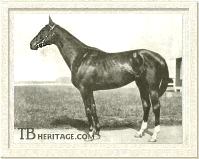
Burgomaster
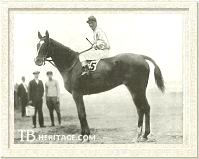
Borrow
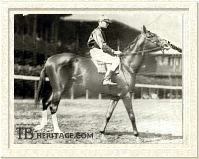
Dandelion
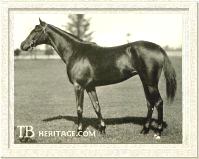
Artful
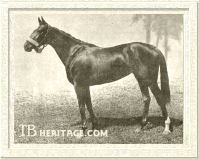
Hamburg Belle
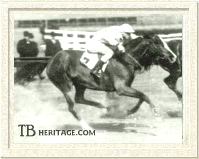
Frizette. Courtesy Keeneland Library. Used with permission.
| |
Hamburg's male line did not breed on, though his son BURGOMASTER has a successful stud career in South America. But Hamburg, like Domino, has his blood flowing through a great majority of today's thoroughbreds because of daughters, three in particular, which became very influential.
Hamburg sired two exceptional racing fillies in Artful and Hamburg Belle, both of which beat colts to capture the Futurity Stakes. Hamburg's daughter Frizette was a good stakes winner, and at stud, became a producer of the highest order.
Hamburg's daughters became very valuable as broodmares. His daughter Jersey Lightning assured her place in racing history as the dam of Regret, the first, and for sixty-five years, the only filly to win the Kentucky Derby. ZUNA produced Golden Broom, contemporary of Man o' War. Paul Jones, winner of the Kentucky Derby in 1920, was produced from Hamburg's daughter MAY FLORENCE. Travers Stakes winner Sun Flag, by Sun Briar, was a son of the Hamburg mare PRIVATE FLAG. BITURCA was the dam of U.S. Champion 2 and 3 year old filly Maskette, and third dam of Bubbling Over. LADY HAMBURG II produced the Brooklyn Derby winner and sire Chicle; Dis Donc, sire of the great race filly Top Flight, and Whiskalong. Other good stakes winners produced from Hamburg mares included Valorous, Erin, Twitter, Celandria, Coquette, and Laurano, winner of the Metropolitan Handicap.
ADRIANA, out of Kildeer, by Darebin, produced two stakes winners herself, the aforementioned Celandria and Coquette, but it was her granddaughter, Ariadne, by Light Brigade, who provided the link to future generations. Ariadne was the dam of the great champion Discovery, who at stud became the broodmare sire of two of the most influential stallions of the twentieth century--Bold Ruler and Native Dancer.
Rosie o' Grady, out of CHEROKEE ROSE II, won the Fashion Stakes and the Clover Stakes. In the stud, she produced stakes-winning filly and producer Erin, dam of Bold Irish, and through her second dam of Broodmare of the Year Shenanigans, dam of champion filly Ruffian and sires Icecapade and Buckfinder. Rosie o'Grady also produced Potheen, dam of champion filly Bewitch and handicap star Pot o' Luck.
Frizette
FRIZETTE was a moderately successful filly on the track, she won some minor stakes, but it was for her significance as a broodmare that the New York Racing Association named one of its most prestigious races for juvenile fillies in her honor. Bred and raced early in her career by James R. Keene, and then passed into the ownership of Herman Duryea, who took her to his stud farm in France for broodmare duty. After his death, she passed into the ownership the legendary French breeder, Marcel Boussac.
Frizette was out of the St. Simon mare Ondulee. Her second dam was Ornis, by Bend Or, out of Epsom Derby winning filly Shotover. With such bloodlines, it would have been a major disappointment if Frizette had not made a nice producer. As it turned out, she became an influential broodmare in both Europe and the United States. A list of some of her most notable descendants include French classic winning filly Diademe, classic winner and leading stallion Tourbillon, French racing stars Priam II and Djeddah; champion American filly and foundation mare Myrtlewood; champion filly Durazna; Miss Dogwood and her daughter Sequence; champion filly Myrtle Charm; stakes winning fillies Black Curl and her daughter Black Wave, the latter dam of Kentucky Derby winner Jet Pilot; champion American mare Vagrancy and her English classic-winning son Black Tarquin; Coaching Club American Oaks and Alabama Stakes victress Hypnotic; Alabama Stakes winner Vienna; stakes winner and sire Tiger; and Kentucky Derby winner Ferdinand.
|
Two of Frizette's most important descendants were Seattle Slew, Triple Crown champion and highly successful stallion, and Mr. Prospector, an influential stallion. Between them, these two stallions have been responsible for over 200 stakes winners, and will be prominent in international pedigrees for generations to come.
Hamburg is not generally remembered as a progenitor of lasting influence in male descent, but through his remarkable daughters his blood flows through the veins of the champions of today.
--Elizabeth Martiniak
|
|
|
|

